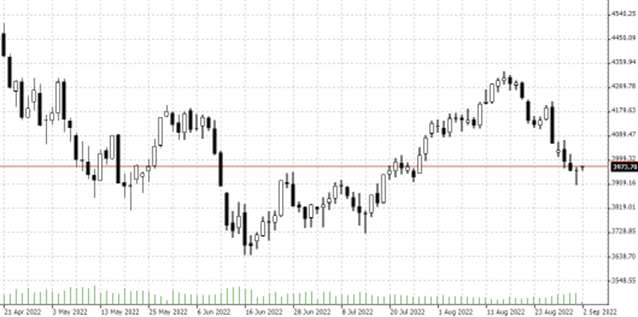

02.09.2022 – So far, the skeptics have been right: the bull run of the past few weeks was probably just an interim rally in a larger bear market. And if these augurs continue to be right, there is more to come. So let’s let some bearish analysts have their say again.
The S&P 500 has now eaten back about half of its gains from the interim rally that began in June. The picture shows the daily chart.

Source: Bernstein Bank GmbH
And so it could continue: Wall Street’s biggest bear, Michael Wilson of Morgan Stanley, speaking to Bloomberg Markets on Wednesday, predicted “gloom and doom” – in other words, a veritable bloodbath on the stock markets.
Profit slump ahead
The current downturn, he said, is just the beginning of the next step down. Specifically, Wilson explained, “US stock indexes haven’t yet hit bottom for the year.” That’s because the trend in operating margins is worse than expected, he said. The stock market is far too optimistic about earnings expectations, he said. Between September and December, the market should pull in its bottom. Wilson also got specific: “We view 3,400 for the growth recession or soft landing.” This makes us wonder: what happens if there is a real, hard recession, i.e. no soft landing?
Goldman sees 3,150 in recession
Goldman Sachs recently provided a possible answer to this question. Chief Equity Strategist David Kostin predicted a target price of 3,150 for the S&P 500 in the event of a harsh recession. And just yesterday, Chris Montagu of Citibank spoke out: there is “little interest in dip buying at the moment. (…) Investors are struggling to contend with the prospect of further interest rate rises against an increasingly weak economic backdrop.”
The Fed is always too late
Incidentally, Morgan Stanley’s Wilson is not banking on the Federal Reserve intervening in time. He says important signals, such as from the labor market, are always just a look back: “By the time the labor market falls apart, it’s too late.” Which brings us elegantly to the events of the day. This Friday, all eyes will once again be on the figures for the U.S. labor market – by the time you read these lines, you will probably already know more.
The Labor Department will report a moderate gain of 300,000 jobs, according to most analysts, which would be a small drop from July’s gain of 528,000. What’s more, hourly wages are forecast to rise 5.3 percent year over year. Which could vindicate the Federal Reserve’s tightening policy. To be sure, bullish numbers could toss the stock market around again. But the buying restraint could also continue until mid-September, when the inflation data come in – the last important figures before the next Fed meeting. Whether long or short – Bernstein Bank wishes successful trades and investments!
The content of this publication is for general information purposes only. In this context, it is neither an individual investment recommendation or advice nor an offer to purchase or sell securities or other financial products. The content in question and all the information contained therein do not in any way replace individual investor- or investment-oriented advice. No reliable forecast or indication for the future is possible with respect to any presentation or information on the present or past performance of the relevant underlying assets. All information and data presented in this publication are based on reliable sources. However, Bernstein Bank does not guarantee that the information and data contained in this publication is up-to-date, correct and complete. Securities traded on the financial markets are subject to price fluctuations. A contract for difference (CFD) is also a financial instrument with leverage effect. Against this backdrop, CFD trading involves a high risk up to the point of total loss and may not be suitable for all investors. Therefore, make sure that you have fully understood all the correlating risks. If necessary, ask for independent advice. CFDs are complex instruments and are associated with the high risk of losing money quickly because of the leverage effect. 68% of retail investor accounts lose money trading CFD with this provider. You should consider whether you understand how CFD work and whether you can afford to take the high risk of losing your money.7
